|
In the first part of this story we left you with the following:
In 1965, Walt and Roy Disney hosted a dinner to honor all the Disneyland employees who had been with the Park since opening. Walt Disney himself presented Earl Wilmer with his 10-year service plaque.
Just a year later, Walt was gone, and the company seemed to change.
We now continue and conclude this untold story...
As Judith Parker notes, “My father loved and worshipped Walt for his vision and meticulousness. He loved to tell a story about a fully-grown tree in the Park that Walt ordered to be moved 6 inches because it didn't conform to the vision he had of the area. After Walt died, my father despaired that the company was being taken over by MBAs from USC.”
With his boss and fellow steam train enthusiast gone, Earl thought about retiring himself. He had seen a lot in his life; the sooty bowels of the Kansas City Southern roundhouse; the hot, yellow Persian deserts during wartime; the steaming jungles of Venezuela. Perhaps now was the time to think about growing a little vegetable garden in the back yard. Play some golf. Maybe do a little fishing…
But Roger Broggie had other plans for Vilmer. One day he called Earl into his office to discuss a new project. Walt had previously shared his vision of “Disney World” on television—an ambitious development in central Florida that would encompass many thousands of acres. And, it would include a version of Disneyland within the property, which would eventually be known as the “Magic Kingdom.” Like its California counterpart, a railroad would circle its berm—and someone would have to supervise the project from beginning to end. How could this veteran railroader with steam in his blood walk away from such an opportunity? He didn’t, and Earl got to work straight away. Retirement would just have to wait.

One of Walt Disney's final film appearances promoted the Florida Project
The first order of business was to procure the steam locomotives. Because Disneyland had saved money on the Park’s third and fourth locomotives by purchasing the engines used and refurbishing them instead of building them from scratch as they had done with the first two, it was determined to try and find suitable used locomotives for Florida.
In October 1967, Earl took a series of flights that eventually landed him in Merida, Mexico, on the Yucatan peninsula. There, a branch of the United Railways of the Yucatan was still operating narrow gauge steam locomotives, using them to haul hemp, sugar and passengers. They were known as “rope trains,” and the locomotives were called “Fire Bulls,” in the local Mayan dialect. Vilmer inspected four locomotives, and reported back to Roger Broggie in a memo dated October 21, 1968: “The four steam locomotives inspected at Merida, Mexico are in good condition compared to [Disneyland’s] #3 and #4 when received. One of the engines came 100 miles under its own power on the day I saw it. The locomotives are standard narrow gauge and are considerably larger and heavier than the Disneyland engines, however I believe they can be fitted to our need in Florida after the Disney treatment.”
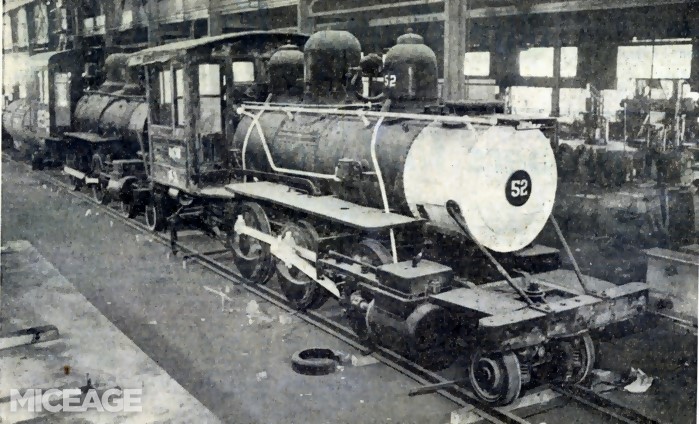
This photo from the August 22, 1969 Tampa Times is one of the few that shows a fifth engine Earl purchased at the last minute for the Walt Disney World Railroad in Merida. However, it was never
worked on. Its appearance is similar to the four other engines before they were restored.
Negotiations ensued, and eventually the locomotives were acquired from the Mexican government. Of course, they needed lots of work to meet the high Disney standard of appearance and reliability, and a suitable shop facility was required to transform the engines. Vilmer suggested the Tampa Ship Repair and Dry Dock Co., after negotiating a price for labor and materials. While the shipyard workers may not have been skilled in steam locomotive rebuilding, Vilmer could teach them, and the shipyards were a suitable heavy-industrial facility that could accommodate large machinery such as steam locomotives.
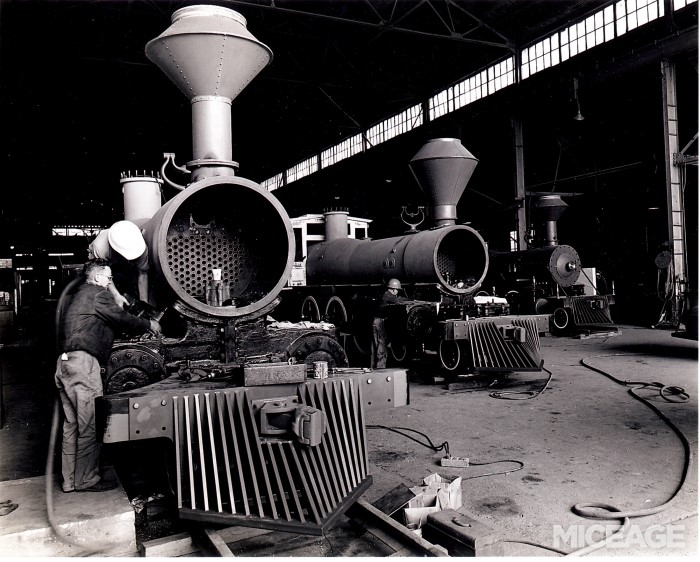
The cavernous facilities at the Tampa Shipyard proved ideal for rebuilding vintage steam locomotives.
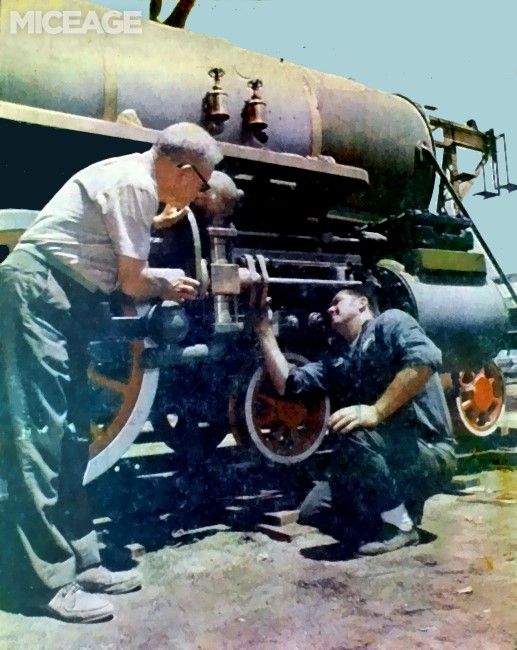
Earl Vilmer, on the left, assists George Britton in polishing the water pump
on one of the WDW RR locomotives. Britton was a Tampa Shipyard
employee who went on to supervise the steam train program at the
Park for the next three and a half decades.
Over the next three years, work continued on the engines, and Earl also supervised the construction of four complete sets of cars that the engines would pull. As part of the project, Earl reprised the role he had during Disneyland’s construction, and oversaw the building of the main line around the Magic Kingdom, as well as the horse car track on Main Street. It was déjà vu all over again!

In what appears to be a staged version of the same scene at Disneyland shown in part one of
this story, Earl Vilmer checks the horse car track gauge at the Magic Kingdom. Even the
welder on the right has assumed a similar pose and costume!
Engine No. 2, the Lilly Belle, was the first locomotive completed in May 1971, with two others arriving by July. With three train sets finished prior to Park opening, Earl assisted Mickey Mouse in driving the golden spike signifying the railroad’s completion. The Magic Kingdom was unveiled to the world on October 1, 1971, with three gleaming steam trains rolling along meticulously groomed tracks. The fourth locomotive would be completed by December, rounding out the quartet of steam locomotives that continue to puff proudly around the Park to this day.
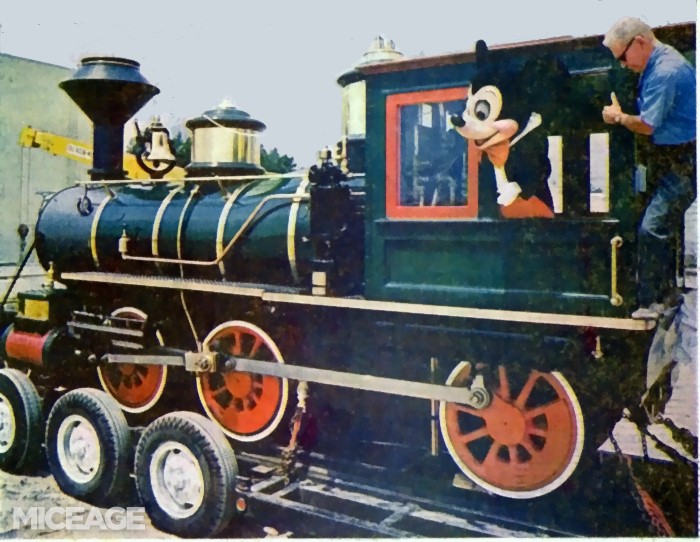
Earl rides the Lilly Belle with Mickey as the locomotive makes its way to the tracks
of the Walt Disney World Railroad.
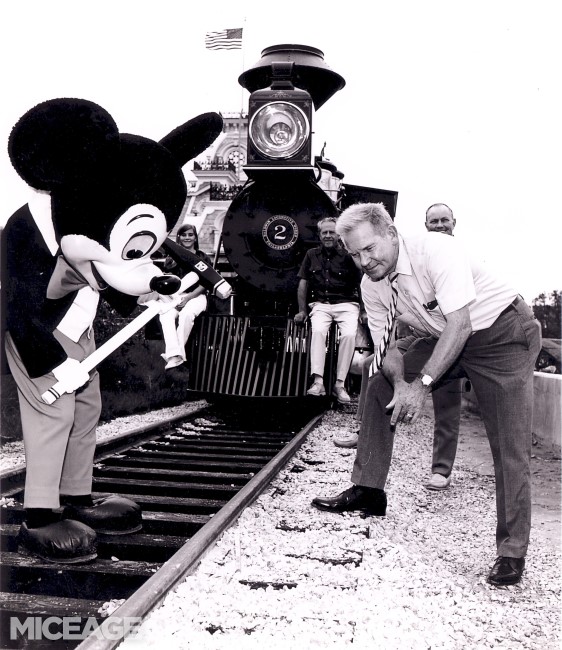
Earl assists Mickey Mouse himself with driving the “golden spike”
that signified completion of the Walt Disney World Railroad.
For Earl Vilmer, the opening of the Florida Park couldn’t have been a higher note on which to end. He had been with the Disney Company for 17 years, built two railroads from the ground up, and supervised the construction and rebuilding of several locomotives and train sets. Now, it really was time for him to retire. In a letter to Admiral Joe Fowler dated December 3, 1971, Earl announced that his retirement would commence on January 1, 1972.
Earl stayed in Florida with his wife of nearly 50 years, enjoying a quiet retirement, but the spirit of adventure never left him. Daughter Judith writes, “He wanted to travel, but my mother didn’t…So he puttered around in his tool shop in the garage and fixed things and invented solutions to household inconveniences or problems.” The Vilmers would often go out dining and dancing. “He was a great dancer and I always enjoyed dancing with him,” Judith recalls.
On March 17, 1981, Earl Vilmer passed away. Earl had seen much in his 75 years; he had traveled the world, all the while being involved with steam locomotives and railways in one form or another. His Midwestern upbringing and love of steam trains no doubt endeared him to Walt Disney—the two shared much in common on the separate paths of their lives that eventually intersected in an Anaheim orange grove. Of all things, Walt Disney wanted his Park to be surrounded by a train. Earl Vilmer, was the person responsible for making Disney’s dream of the Disneyland Railroad into a reality—an Imagineer whose story is little-known—but deserves to be told.
Postscript
I would very much like to thank Dr. Judith Parker, Earl Vilmer’s daughter, for entrusting me to tell the story of her father. She also entrusted me with Earl’s memorabilia from his Disney days. Without these documents and photos, this story could not have been presented. The idea for this story actually began when Judith found out her father did not have a Disney Legend award—and in fact had never even been nominated. It is our hope that as more people become aware of Earl Vilmer’s immense contributions to the two domestic Disney Theme Parks, he will be honored with a Legend award—a tribute long past due. |
